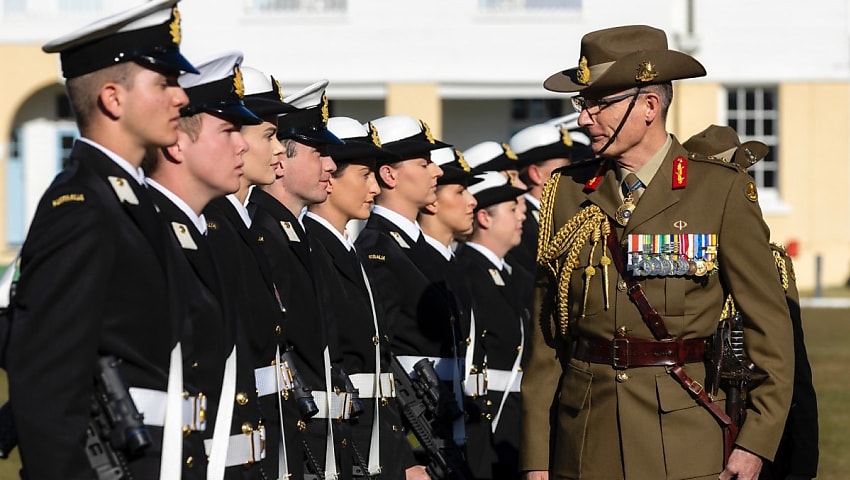The Australian Defence Force is “under stress” as it operates with more than 4,308 people below its authorised strength and attracts recruitment rates below the required level to man the current force, according to new information unveiled in a recent Senate estimates meeting.
Australia will require “considerable effort to remediate recruiting and retention challenges”, according to comments made during the Senate foreign affairs, defence and trade legislation committee (Senate estimates) on 14 February this year.
Chief of the Defence Force General Angus Campbell, speaking at the Senate estimates this week, said current inflow rates remain below the level required to maintain the Defence Force.
“Recruiting and retention, Defence is addressing retention and recruitment as a priority. As at 1 January 2024, the ADF is 6.9 per cent, or 4,308 people, below its authorised strength (of total 62,735),” he said.
“Recruiting performance is highly correlated with unemployment: low unemployment, low recruiting, and vice versa.
“Nevertheless, considerable effort and innovation continue to inform changes to our recruiting system, focused in four areas of activity.
“Firstly, widening the aperture of eligibility to increase the number of potential applicants who might wish to join the ADF, including through consideration of non-citizen enlistment on a pathway to citizenship.
“Secondly, increasing the capacity of the recruiting system to manage a greater volume of applicants.
“Thirdly, improving recruiting processes so as to accelerate and thereby shorten the time taken to recruit an applicant.
“And finally, encouraging our people to remain in service through targeted retention initiatives. There have been some early encouraging results.
“Separation rates have declined from a high of 11.6 per cent per annum to 10 per cent, as at 1 February 2024. The size of our Air Force is at a 20-year high. The Australian Defence Force Academy has just commenced one of its largest intakes of trainee officers. Last year, Army graduated its largest cohort from the Royal Military College.
“Nevertheless, a considerable effort continues to be required to remediate our recruiting and retention challenges.”
Recruitment remains a reoccurring issue across the ADF, APS, and defence industry, according to information released under the Defence Strategic Review (DSR) unveiled by Prime Minister Anthony Albanese, Defence Minister Richard Marles, and Defence Industry Minister Pat Conroy in April 2023.
The DSR stated that recruitment would continue to deteriorate without creative and flexible responses, while also recommending an increase in recruitment speed from application to enlistment to recruitment and the process of recruitment should be achieved in days, not months.
General Campbell said there are significant implications involved with any defence force operating 4,500 personnel below requirement.
“It puts stress across the entire organisation in terms of being able to train and recruit, to conduct activity, to sustain our people, support their families, and continue our tempo of activity, both internationally and domestically,” he said.
“As an example, our aspiration for recruiting is higher than it might otherwise be because we’re trying to fill the hole that has been established. That means we need to see more people working in our recruiting system and more people working in our initial induction training recruit system and early employment system.
“Those people need to be high-quality NCOs and officers who can impart learning, and the culture and behaviours, attitudes and professional skills that we aspire to see. To realise that, they are coming from the organisation’s regiment squadrons, potentially ships’ companies, that otherwise would be in the operational component of the force. The more stress in recruiting or in retention, the more stress filters across the system.
“We do live in an environment in which there are a demanding range of strategic circumstances that necessitate the ADF’s preparedness, capacity, presence and engagement. In terms of the wellbeing and building of the force, both today and into the future, recruitment and retention of our people is the critical component of our work.
“I think all three services are under varying degrees of stress. Not only is it important to note the deficiency in authorised strength numbers, also, there is the differentiation across the variety of skill sets within that deficiency of number.
“We see across all three services the more technical aspects of our spread of employment activity. The more technical aspects are under more immediate stress, then there is the general stress of trying to sustain and maintain the range of presence, engagements, and operational and exercising activities that the Defence Force is responsible for.
“I could summarise that by saying it is complicated and it is really about types of workforce skill set, and all three services are experiencing that stress, as indeed are those areas responsible for our competencies in space and cyber activities.”
Senator David Shoebridge, speaking at the Senate estimates meeting, questioned whether the Australian Defence Force had too many supervising personnel in relation to frontline soldiers.
“On the numbers we’ve now got, with 238 generals and some 58,000 troops, there’s one starred officer, general or admiral for every 245 other personnel in the ADF,” he said.
“If we go to those other forces; if we go to the United States, it’s one star ranked officer for every 1,526 personnel. If we go to the United Kingdom, it’s one starred officer for every 1,250 other personnel.
“Australia is so out of whack. There are so many chiefs, so many generals, so many stars and so few people to do the work.”


